more cow stuff, I’m in it for the long run
Most information available about rotational grazing usually deals with huge acreages and large herds of cattle. Daunting information for someone with a small herd of cattle or a few sheep or goats. The logistics of getting power to the fence, water to the stock, and the idea of building fence every day puts people off. It is too different, the vast choice of supplies is mind boggling, and while somewhat scientific, it requires that the stockman be present in mind and body to really understand the entire biological process, which many times flies in the face of spread sheets.
I have been writing this series of posts to show that you don’t need hundreds of cattle, sheep, and poultry, or a huge landbase to rotationally graze the stock you have. You don’t need to spend thousands of dollars on a permanent water system, or buy expensive electric fencing supplies, or fancy pasture seeds to get started. You just need to start. Ruminants have been grazing for millenia, without all that. If you decide you like moving your animals, you can add refinements later.

Just graze what you have, good timing of grazing (disturbance) and adequate rest will push your pasture plants forward in succession, too much disturbance (for instance continuous grazing and impact even with different species ) without rest will push your pasture backwards in succession making your land less productive in the long run. A good example for forward succession would be ruminants, then poultry to fertilize and scratch through manure. Ideally it would be ruminants one day, poultry for 2 -3 days, then rest for as long as you can, somewhere in the ballpark of 60- 90 days before you put animals on that land again. The whole idea of rest is abhorrent to most, the land and forage is being “wasted” if it isn’t continually harvested. It helps to look at your land and pasture like a savings account, saving your grass through rest and stockpiling it, isn’t wasting it, squandering it with a bite here and there is.
This strip the cows have been in this week, was grazed once in early May, the grass was tender new spring growth, so the cows had access to the entire strip for one day. Now in July, the grass is well rested, and recovered. They have grazed the same acreage for 8 days, but in much smaller paddocks, approximately 5000- 6000 square feet.

Today was the last day for the strip. Here is where you see if you allotted enough for one days grazing or not. When I drive into the field, I want to see the cows interested in my activities, but I also want to see some at rest, nursing and not bawling their heads off, because I shorted them. Their reactions show me if I am on the right track with my paddock size. If I didn’t judge the grass correctly and shorted them, I can correct that the next day, likewise if I gave them too much, I can make the next paddock smaller.
Depending where I am in the rotation, it may take me 15 minutes to build fence, move cows, water and minerals or if I have to build a strip fence that will be the foundation for a weeks grazing, it may take me an hour. If I had more cows it still wouldn’t take much longer, I have to be there anyway, it doesn’t take the cows long to walk into the next paddock. I do have to fill my water tank though beforehand, so that means I have to keep an eye on that, but that is a multi-tasking sort of thing.
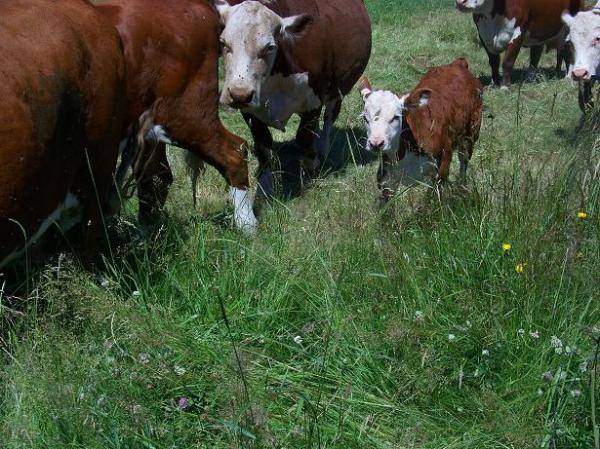
During the hot weather, I move the cows in late afternoon, they can fill up and ruminate in the cool of the night. If the grass is ample enough, they can eat their fill in about 4 hours or so. You don’t want to see a ruminant grazing all day – if you do your grass is too short. And if you’re in a situation where drought is affecting your pasture, pull off your stock to a sacrifice area and feed hay. Giving them access to stressed pasture is really costing you in the long run.
My routine is to take down the back fence and rebuild it ahead of the cows, it becomes the front fence. The back fence is important to prevent the second bite. The second bite is when livestock have access to the recently grazed grass that begins growing. By allowing your stock to access to that tender grass, the grass plant is weakened and you can lose 40% of your grass growing potential in a season. That is a lot of grass or hay to have to feed.
At each new paddock the cattle always travel to the very end to see where fence is and check things out.
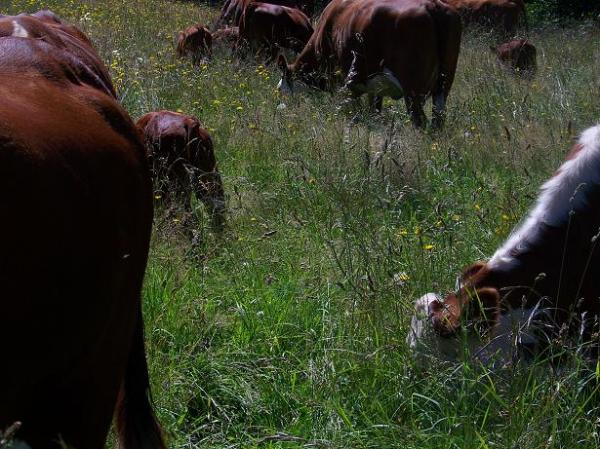
After ascertaining where the new fence perimeter is, they fall to grazing without delay.
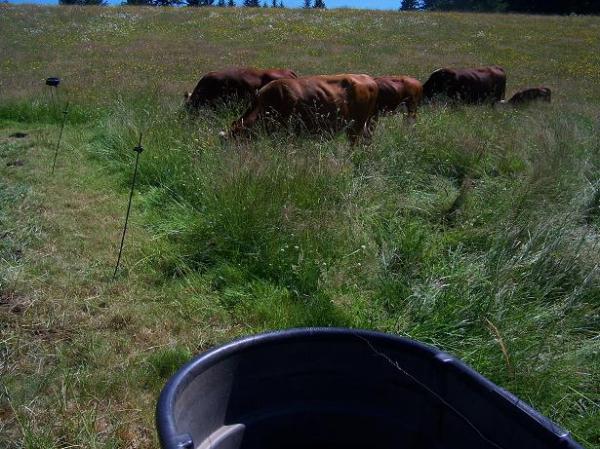 Back fence formerly the front fence.
Back fence formerly the front fence.
Since this is the last paddock of this strip, I won’t move the water trough(s) ahead. While the trough is filling I will carry the mineral box to the new back fence (formerly the front fence.) I like to place the minerals near the back fence instead of the front fence because every once in a while a beef ensues over minerals (like a political argument at the water cooler for us) and someone may get shoved through the fence. The way it works with livestock if someone gets pushed out into the old, grazed manured paddock no one cares (but me.) But, if someone gets rammed into the the adjacent grass that hasn’t been grazed yet, all heck breaks loose and the stock will brave the fence and get out, because someone is getting something good (new grass.) Not the end of the world but it sure wreaks havoc with the grazing rotation. 😉
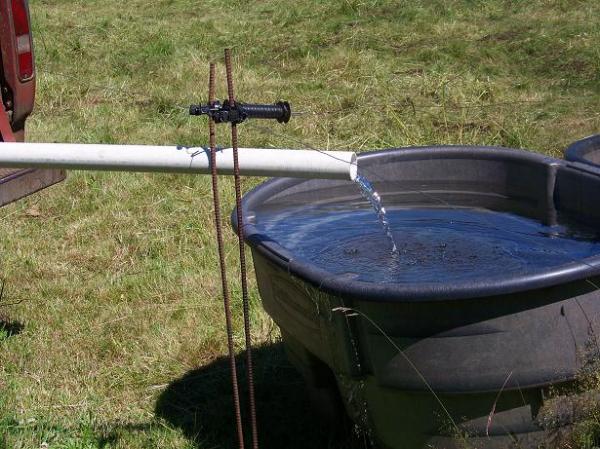
The watering set-up I am using is pretty low-tech. A 300 gallon tote with a valve, several different size lengths of 2½” PVC pipe, and pipe wrench to open and close the valve because the tabs are long since gone.

I can get creative with trough placement with these two pipe lengths – the short piece has 90 degree elbow on one end, and a coupler on the other end. Usually my vehicle stays outside the fence, to deliver the water I park either perpendicular or parallel to the fence, and depending on the terrain, sometimes I need the two pipes together for length or I can use the 90 degree end for sideways water delivery.
This poor boy water system works fine; it is an inexpensive way to get started, it’s portable, and gives me more bang for my buck on manure placement. This works well for us, utilizes our water supply perfectly, and would be a good place to start if you’re not sure you really want to install a more permanent water system, or know quite were to place it. If you can afford a more fixed system, and have flat fields by all means go for it.
 Loose minerals, available free choice.
Loose minerals, available free choice.
I like the hands-on of rotational grazing, and the improvements we have made to our pastures by managing the whole. During the grazing season the cows are harvesting their own feed, and we make the surplus into hay for winter feeding. By keeping the cows in during the winter feeding period, we can can gather enough manure in a deep bedding system for fertilizing the paddocks we cut for hay.
Look at your farm as an entire organism, each part helping and enhancing the next and believe me it will look different to you.

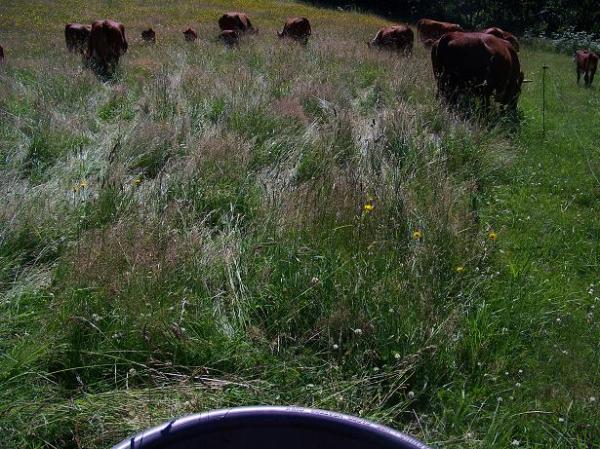


I’m really enjoying your posts on rotational grazing. I only have chickens (we are on an urban lot of about 1/3 acre) but I’m thinking a lot about how to apply the principles to my girls.
Mareena, thanks, I am glad to put the idea out there – it really makes so much difference, no matter what size your dealing with.
Your post left me wondering about how much land it would take to do this, so I did a few calculations — of course, as you say, you need to experiment to find out how large a paddock should be, but I don’t own land yet and am hoping to buy some for a dairy cow in the future, so I will need a reasonable estimate so I can buy an appropriate amount of land.
Usually I see recommendations of 5 acres for a small herd like I want. Using rotational grazing, say a 90-day cycle, with 2 days in each paddock, you would need to divide the land into about 46 paddocks. If each paddock is 6,000 sq ft, that would be about 6 1/3 acres. That’s what you get using all your most conservative numbers — using a 60-day cycle with 3 days in each 5,000 sq ft paddock, you don’t even quite need 2 1/2 acres. So it seems like 5-6 acres of direct grazing land is still a good number to shoot for. I assume I will need additional land for haying.
I guess there is probably a good amount of variation in these numbers based on climate and soil and cattle breeds all that good stuff. But this seems to be a good starting point.
Anyway, thanks as always for a very informative post!
Laura, that sounds about right, just keep in mind that you change the size of paddock to match the grass growth curve. I might cover 50 acres in 7-14 days when grass is short and tender to now when it takes much more time because the grass is fully recovered. My single milk cow would graze about a 10′ x 15′ area each day.
Find out what your extension office recommends for cows per acre, and then at least double the number of head if you rotationally graze. That is on fairly good ground, if it is full of blackberries or too many noxious weeds that may make quite a difference making the extension figure more accurate even with rotational grazing.
Thanks for the 10’x15′ guide for your single family cow! How do you set up a paddock that small? And provide water?
And would you mind posting a picture of your mineral box? Does your mix include salt? What do you do when it rains?
Our land is so poor. Logged 50 years ago so all the top soil clogged what was once a large stream. We’re restoring it and figure we’re like Joel Salatin’s parents. We’re taking a multi generational view. Filling gullies, building top soil.
Really enjoying these grazing posts!
Kristin, here is the mineral box, he used 2″ x 8″ tongue groove decking scraps, and originally it was screwed together, but as it dries out in the summer, it started to get loose in the joints if the cows horsed around too much with it. So he added the corner brackets and now it has held up for several years with any more loosening. I’m using Fertrell Poultry Nutribalancer(contains Redmond salt), and Thorvin kelp the most. Once in awhile, I offer Redmond salt, sulfur, copper, & Azomite but not every day, maybe once a week or so. If it is raining, I don’t put out minerals, I wait until there is a dry period or two of a couple of hours or so. Someone gave me an expensive covered mineral feeder made by Brower, I found it too heavy to move, and timid animals didn’t really use it. It would probably work well for a fixed pasture setup, and probably eventually even the timid ones would get desperate enough to use it. My young stock eats the most minerals and they were the most reluctant, so I like the open box for my needs.
As for the milk cow in small paddocks, she had the chore of grazing the headlands around the gardens, so I would build a lane and inch her forward each day to new grass. I didn’t use a back fence because I really wanted to set the grass back and keep it short, so she was allowed to come back to the barn for water. She rarely did, though since she preferred to fill her tank at the water trough before each milking.
Congratulations on bringing your land back into production – we have an area like that we have been “improving” for 15 years. It takes a long time – our daughter has learned right alongside us, she will be able to do more than us since she learned this at an early age.
What do you do for minerals during the winter months? I’m thinking that your area probably receives rain like we in Western WA do. Also, where do you get your Thorvin kelp?
Amy, we do gets lots of rain, but many times there are many hours in a day that we don’t – so I play it by ear and only offer what I think they will clean up in a few hours. I pretty much now know what to offer when, for instance if they are near a hedge or in the woods where they have access to browse they won’t touch minerals, so there is no point in even offering them. And when it comes time to bring them in for the winter feeding period, the mineral box is indoors.
Azure Standard is the easiest place for me to purchase the kelp or I can also buy Acadian at the same feedstore that I get my milk replacer from. There is Acadian in the Fertrell minerals, but for just straight kelp the cows prefer Thorvin. Oh and sorry about the way the comment appears – by inserting the image in the comment section it has made this comment hard to read – I have no idea how to fix this…
We have two horses and a number of chickens on our tiny two acres, but we rotate everyone among 6 different small pastures. We can’t rest our pasturage for the recommended 60-90 days, but each pasture gets about 2-3 weeks off, depending on the weather. So far, we still have decent grass, even though we live in central Texas and we don’t get a lot of rain. We do keep the horses on a dry lot at night, so the pastures are only grazed for 12 hours per day, but still – rotational grazing makes all the difference!
You’re right, it’s not expensive or time-consuming to do rotational grazing. We got some inexpensive hot tape and step-in posts, with caps for safety. Once we figured out the general shape and size for each pasture, we added a few permanent tie-in points to our perimeter hot fence, so it only takes 15 minutes or so to move the fenceline and connect it. We’ve had several neighbors comment on how nice and green our land is, and wonder why theirs is so overgrazed and full of weeds. I definitely recommend trying it, even if (or especially if!) your land is small.
Jen, it sure is amazing isn’t it when you see the difference it makes. I always wonder why more people don’t practice rotational grazing. Kudos to you for such successful grazing in Texas!!
What are the minerals in? I’m assuming you aren’t throwing them on the ground.
Rita, my DH made me a mineral box out of 2 x 8 tongue and groove decking. It is 2′ square and is heavy enough to withstand a cow fight, they can’t tip it over like a rubber tub, and it is light enough I can pick it up and carry it to the next paddock each day. I couldn’t afford to throw them on the ground at $60 per bag.
Your blog is a wealth of great information! Once our real estate drama is behind us, and we’re on our new farm, I’ll be putting some of what I’ve learned here into practice. 🙂 Thanks!
Michelle, thank you! Nice comments like this make setting this down worth it. 🙂
I love these instructional posts. Our little herd of 3 cows and 2 calves is currently in the sacrifice paddock eating hay while our pastures, which hubby mowed a couple of weeks ago, recovers. I see a little improvement already, but we have to be patient. That’s the hard thing…hubby sees a couple of inches of new growth – even if it’s just spotty – and thinks, “Hot damn, let’s let the cattle out!” Thankfully he listens to me when I screech, “Noooooooooo! It’s not ready yet!” 🙂
We plan to spread chicken manure this fall and hope for even more improvement on the quality and variety in our pastures come spring.
Amy, I know it’s funny what that screeching can do isn’t it 😉 You will love the results of the manure application – nothing short of amazing.
This is so interesting! If I were younger, I’d put what you’ve learned into practice!
Linda, thanks! It sure is an interesting way to farm 🙂
Very informative. Thank you.
I still don’t get how the cows don’t run away when you move the fence. If you move one side the formerly closed side is now open and the cows can get out.
Kimberly, that is the beauty of rotational grazing a herd, they come to expect to go to good feed as long as you keep a schedule and move them at about the same time each day. They don’t want to go where there is no feed and solid manure, they want to go forward to the fresh grass. The fence is off while I am working, and they just wait patiently for me to finish and give the call. But your question is exactly what I thought would happen when we started rotational grazing, since my experience with our cows were that they had to be fenced, and chased and man-handled any time you wanted them to do something. So now every interaction between us is good, especially if you’re not a steer 🙂 Much less stress on the handler and the stock!
Your pictures of the pasture, the paddock shifts and grazed paddocks are great, but I wanted to say that pictures don’t fully convey what standing in a freshly grazed paddock surrounded by ungrazed pasture feels like. The grazed paddock draws me down to it somehow and the ungrazed grass starts to look soo tall, yet the fresh grazing makes the previous paddock feel somehow lush and inviting and definitely not exhausted like a continuously grazed paddock. It’s a weird but pleasant sensation. I get a big thrill seeing those cows do such great work and graze so enthusiastically, and I notice I’m enjoying your pictures and your grazing posts even more now that I have some experience trying it out for myself.
Since about a week now, the five girls have taken to eating weeds. I don’t know why that is. It could be the switch from timothy pastures to mostly browntop at the moment, or maybe their tastes changed. I did ask them to, as well. They started picking yarrow flowers, then yarrow stems and leaves, and went on to eat fireweed, oxeye daisies and willow saplings. 🙂 I’m giving them about ten by ten paces paddocks with twice daily moves now. I think I’ll start making the paddocks a bit smaller for the hot day and a bit bigger for the cool nights from now, as that’s the way the cows appetite seems to go. The cows are only five and not more than a couple of hundred yards away from the house, so I’ve been hauling buckets on a milk cart for their water. That looks to be the least amount of work for now, and with a dry spell, the pasture doesn’t seem to take too well to the water lane travel that comes with a bathtub water point and electric fence lanes. Maybe in a year or two when the pasture’s getting better.
Many thanks again for great posts!
Oh, I forgot to add a link to a one hour talk by Greg Judy that you and the readers here might be interested in, if you haven’t heard it already. It’s very good, sort of like an addendum to Judy’s Comeback Farms book.
http://www.greenpasturesfarm.net/blog.php?entryID=2161&cat=1
Ah! this is what I want to do with our goats!
I just thought I’d let you know that even though we don’t have livestock larger than chickens on our farm, I enjoy reading your rotational grazing posts so much that….last night I dreamed about it. 🙂
This was a very good informative post! I wish that all could see that it works, but they are set in their was and will not try it out.
~David
Thank you for the informative, easy to comprehend posts about rotational grazing!!! We bought 40 acres of undeveloped land last summer in NE WA. Now we are waiting to sell our suburban house on the coast in order to move. We definitely want to set up a rotational grazing system. Can’t imagine doing what we want to without it – that is grow most of our own food!
I would like to hear your thoughts about native meadows fitting into a new grazing system like ours. What I’ve read so far is to just start, without seeding or amending in any way. We’re not sure what grasses and sedges there are, except there is plenty of bunchgrass. Any thoughts would be great!
Krystal, Hi! Yes, starting is the best way. What is growing on your land now is what the land and available fertility will support. If you add animals and disturbance you will see changes to a higher plane of nutritious grasses without seeding. Cattle are a good to start as opposed to smaller species, because they are easier to control with simple electric fencing, and are quite amiable with daily human contact. Any grazing articles by Joel Salatin, Greg Judy or the Holistic Resource Management site is good too.
http://www.holisticmanagement.org/
The problem with seeding before is, it is expensive and most likely if your soil could support the types of forage you are seeking to graze it would be there. Once you get some animal manure spread around you will see a big change. Best of luck to you on your new endeavor!
Thank you so much for reaffirming my thoughts and limited knowledge!!! I’ve been on that Holistic Management site. Did you take a class through them? Or mostly by reading various articles/books? I have Gene Logsdon’s book “All Flesh Is Grass”… excellent, simple. We are starting with cattle (American Milking Devon) and chickens; sheep (Painted Desert) and small hogs (American Guinea Hogs) to follow closely. 😉
Love your blog! By the way, your Sunday chicken is now one of our all time favorites. If I don’t make it, my hubby does it himself! LOL If neither of us can for a few weeks, he’s asking “when are we going to have that chicken again?”
Keep the great information coming!
Krystal, I didn’t take any classes but we subscribed to the In Practice magazine for a number of years. Mostly it is lots of reading and building fence that show what you need to do.
Ah yes, the Sunday chicken – we just came in from the hayfield – pant, pant – I need to chain myself to the stove and get cooking. We had Saturday chicken last night! https://matronofhusbandry.wordpress.com/2009/01/25/at-home-on-the-range/
Anything I can put in the oven and forget for an hour is perfect in my book! Good luck with your grazing!
do you keep a grazing journal to know how long each paddock has been rested or do you just eye ball it?
Ben, I actually keep track of it on a 12 month wall calendar, it’s easy for me to see and it’s there just in case I forget. I also have butcher dates etc on there, so I know when I have to work the corral into my rotation. Kinda kitchen table, but we’re a small operation.